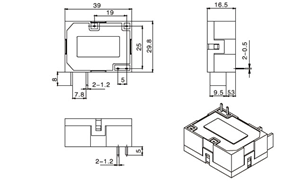In the realm of energy conservation, latching relay technology has emerged as a significant contributor to efficient energy utilization. This advanced relay type differs significantly from traditional relays, offering unique benefits that are particularly relevant in today's energy-conscious world.
100A Magnetic Latching Relay with shunt
A 100A Magnetic Latching Relay with shunt is a crucial component in various electronic and electrical applications. These relays are designed with a magnetic latching feature, which provides a mechanism to hold the relay in either the open or closed position with no power consumption. This is a significant advantage, especially for battery-powered applications where power conservation is critical.
latching relay in future
integrating advanced sensor technologies into closing relays can enhance their functionality and responsiveness. By incorporating sensors such as temperature, pressure, and vibration sensors, relays can monitor the operating conditions in real-time and provide timely feedback to prevent potential faults or malfunctions. This not only increases the reliability of the relays but also enables proactive maintenance and system optimization.
I would like to share with you some thoughts on the future development trends of latching relays. As an electrical component widely used in the field of automation control, latching relays have made considerable progress and have been extensively validated in practical applications. So, what new directions can we expect latching relays to take in the future? Let's explore together.
The accuracy is unchanged for a long time, and there is no need to run the school, no installation and transportation, etc.
Something about Magnetic Latching Relay
Magnetic latching relay factory condition for contact closure state,but because carry or installed when subjected to impact,may change state,therefore before use to make its reset.
Several kinds of relay
Tongue spring relay: a relay that opens, closes or converts the line with tongue spring action that is sealed in the tube and has the dual role of electric shock reed and arbit magnetic circuit
Introduction of Relay
A relay is an electrical control device. It has a control system (also known as input loop) and a quilt The interaction between control systems (also known as output loops). Usually applied to the control of automation
The relay coil is represented in the circuit by a long box symbol, and if the relay has two coils, two long boxes are drawn side by side. At the same time, mark the relay word symbol "J" in or beside the long box. There are two ways to represent the contacts of relays: one is to draw them directly on one side of the long box, which is more intuitive. The other is to draw each contact into its own control circuit according to the needs of the circuit connection. Usually, the contact of the same relay and the coil side are marked with the same text symbol, and the contact group is numbered to show the difference.
Self-locking and interlocking are achieved by auxiliary contacts of relays. First of all, you need to understand what is called self-locking and what is called interlocking. Self-locking is to short off the button switch of the contactor coil loop with your own contacts, and make the coil loop open continuously after the button switch is released, which is self-locking.














